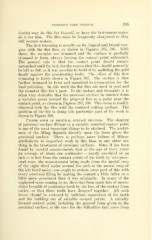Page 611 - My FlipBook
P. 611
FINISHING GOLD FILLINGS. 295
dentist may do this for himself, or have tlie instniment-maker
do it for him. Tlie files must be freciueiitly sharpened or they
will become useless.
The first trimming is usually on the lingual and buccal mar-
gins with the flat files, as shown in Figures 385, 386. With
these, the margins are trimmed and the surface is partially
trimmed to form, always leaving the contact point untouclied.
The general rule is that the contact point should remain
untouched until the last, for the reason that this should generally
be left as full as it was possible to build it by malleting the gold
firmly against the proximating tooth. The effect of this first
trimming is fairly shown in Figure 387. The surface is then
further trimmed to form and smoothed in preparation for the
final polishing. In this work the flat files are used in part and
the rounded files for a part. In the molars and bicuspids it is
often very desirable that the proximal surface be concave from
a variable point toward the gingival line to a point near the
contact point, as shown in Figures 397, 398. This form is readily
obtained with the files with the rounded cutting surface. The
position of the file in doing this particular part of the work is
shown in Figure 388.
Proper form of proximal surface fillings. The shaping
of ijroximal surface fillings to a suitably rounded contact point
is one of the most important things to be attained. The useful-
ness of the filling depends directly upon the form given the
proximal surface. There is perliaps more failure of fillings
attributable to imperfect work in this than in any other one
thing in the treatment of proximal surfaces. Since it has been
found by careful measurements that at the age of forty years
an average of about one centimeter — nearly one-third of an
inch — is lost from the contact points of the teeth by interprox-
imal wear, the measurement being made from the mesial cusp
of the right third molar around the arch to the mesial cusp of
the left third molar, one ought to restore some part of this with
every proximal filling by making the contact a little fuller or a
little more prominent than it was originally. In many of the
neglected cases coming to us, there has been much loss of mesio-
distal breadth of particular teeth by the loss of the contact from
caries, so that these teeth have dropped together. All such
losses should be restored by sufficient separation of the teeth
and the building out of suitable contact points. A suitably
formed contact point, including the general foi'm given to the
proximal surface, is the cure for the difficulties that arise from


